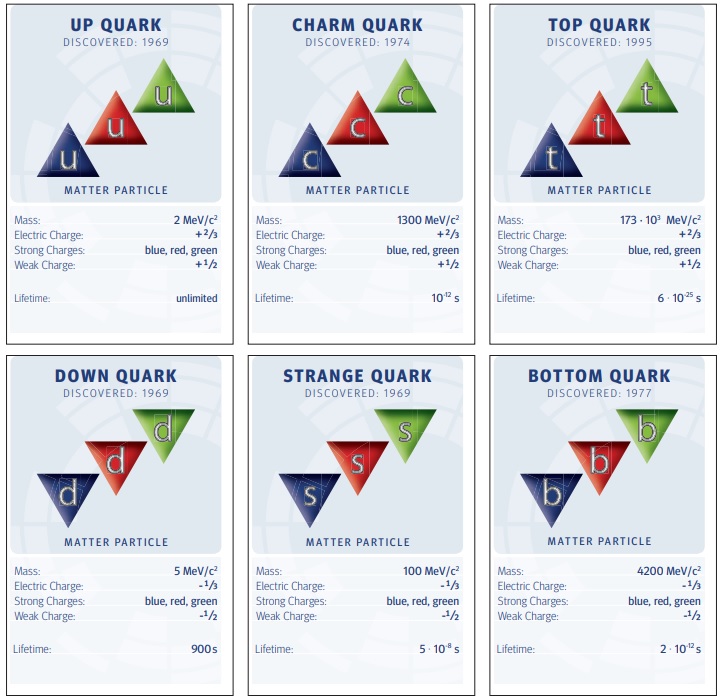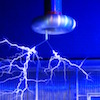Friday Flyer - May 8, 2020

Spotlight on Quarks
Three quarks for Muster Mark!
Sure he has not got much of a bark
And sure any he has it's all beside the mark.
--from Finnegans Wake by James Joyce
Murray Gell-Mann and George Zweig independently proposed the quark model in 1964. Both men proposed that the hadrons of the "particle zoo" were not themselves fundamental but consisted of quarks and antiquarks. Gell-Mann coined the term quark to refer to one of these particles, originally only having the sound "kwork" in mind, with no initial decision on spelling. It wasn't until he came across the words above from Finnegans Wake that he decided on quark. Zweig actually preferred the name ace for this particle, but the term did not stick. Experiments at the Stanford Linear Accelerator Center (SLAC) provided evidence for the existence of the up and down quarks in the late 1960s. The discovery of the massive top quark at Fermilab in 1995 rounded out the full list of six quarks. Of these six particles, only two are commonly found in nature: the up quark and down quark. These, along with the gluons that bind them together, make up the protons (UUD) and neutrons (UDD) of all the atoms in our universe. Quarks have some unique properties when compared with other particles of the Standard Model; they experience all four fundamental forces, they each have fractional electric charge, and they are very "social" in that they don't exist in isolation. (Source: Wikipedia)
You can learn more about quarks from two videos in Don Lincoln's Subatomic Stories series: Introduction to Quarks and the Cosmos and Quarks. You can also check out this interactive standard model from symmetry to learn more details about each quark and other elementary particles. QuarkNet has several activities in the Data Activities Portfolio that feature quarks, including Quark Workbench, Shuffling the Particle Deck, and Calculate the Top Quark Mass.


News from QuarkNet Central
There is a lot going on this month as QuarkNet provides more options for remote learning. Rick Dower presented Neutrinos: History and Mystery, our first QuarkNet Wednesday Webinar (QW2) held this past Wednesday. Next Wednesday, Pedro Machado will present Science at Fermilab. Visit the QW2 page to register you and your students for next week's webinar, or to access the slides, script and recording of Rick Dower's presentation. Another big event this month is a second round of the Big Analysis of Muons in CMS (BAMC). Visit the BAMC Teacher Launch Page for more information including a registration link to be filled out by teachers. Registration for this round of BAMC closes today!
Reminder: Mentors and teachers at each QuarkNet center will decide whether and how they can meet this summer. Also, centers may want us to retool QuarkNet National Workshops such as Neutrino Data Workshop for remote online participation. If your center needs to change plans, postpone a workshop, or move it online, or has any request that might help, please let Spencer, Shane, or Ken know. We can work it out.
Thinking about the AAPT 2020 Summer Meeting in Grand Rapids? It has been changed to a virtual meeting. For more information about this recent announcement, check out the AAPT 2020 Summer Meeting website. Note that the deadline for submitting an abstract for this virtual meeting has been extended to June 3.

Physics Experiment Roundup
While the Deep Underground Neutrino Experiment (DUNE) is under construction in South Dakota, scientists work on developing the computing infrastructure that will be necessary to handle the huge amounts of data that the experiment will produce. At CERN: ATLAS probes dark matter using the Higgs boson. Physicists must collectively juggle the past, present and future as they learn and analyze data from the past, mind current projects, and plan for the future, often several years in advance. Read how scientists from Purdue University are working to upgrade the CMS detector of the future. (H/T to Marla Glover)

Resources
Check out the amazing neutrino and Forces the Feynman way; both recent releases in Don Lincoln's Subatomic Stories series. From Physics Today, read about one man's unique journey from prison to physics. Also from Physics Today, a Q&A with a young experimental physicist and advocate for autistic researchers and people with disabilities. On the COVID front, some updates on physicist contributions, from designing a simplified ventilator to crowdsourcing pandemic problem-solving.

Just for Fun
A few days late (or several days early!), but fun nonetheless: A "May The 4th Be With You" image and tweet from CERN. While on the "few days late" theme, National Teacher Appreciation Day was celebrated this past Tuesday in the U.S. To all of our teachers out there, a big thank you for all that you do, "gems among gems!" (H/T to Marge Bardeen for PEANUTS tweet.)
QuarkNet Staff:
Mark Adams: adams@fnal.gov
Ken Cecire: kcecire@nd.edu
Spencer Pasero: spasero@fnal.gov
Shane Wood: swood5@nd.edu
